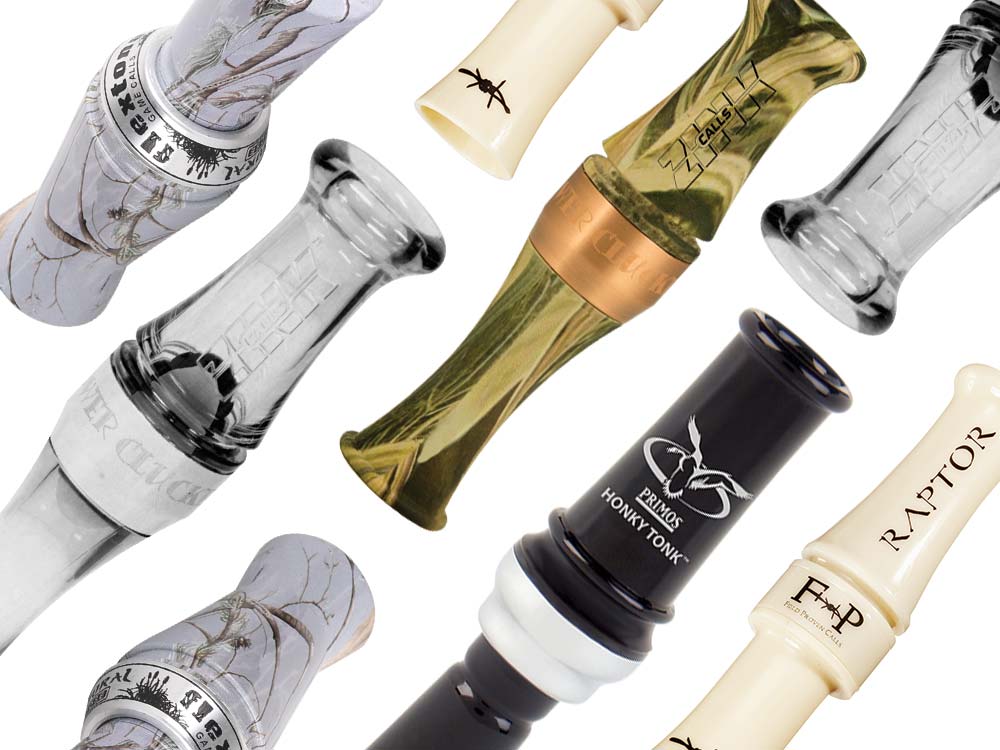We may earn revenue from the products available on this page and participate in affiliate programs. Learn More ›
I’ve always relied on a long, flute-style call when hunting Canada geese, even though it’s cumbersome. The reason is simple: I can easily make goose sounds with it, especially those low, signature honks of a big Canada. I’ve tried short reeds, and even own a couple, but could never make a decent honk on them, let alone a double cluck. So I stuck with my battered old flute despite its bulk.
All that changed last season when I embarked on a quest to find an easy-to-blow short reed that I could actually make goose music with. Besides being easy to operate, there was one other caveat – it also had to be affordable. No way was I going to shell out a hundred bucks (or more) for a custom call I might not even be able to blow. What follows are four economical, easy-to-blow short reeds. All cost around $30 and are ready to call geese right out of the box.
Primos Honky Tonk
The first call I tried was the Honky Tonk, an attractive call from Primos with an ebony finish and contrasting silver band. It may look good, but it sounds even better. I was immediately able to make honks and clucks with it, since the call requires minimal backpressure to operate. With a little practice, the Honky Tonk will reproduce all the calls of a Canada goose. Patented “ditches” in the sounding board prevent the call from sticking, even in bad weather. A free lanyard is included. ($30; Primos)
Zink PC-1 Power Clucker
Zink’s PC-1 was the easiest call for me to operate. It requires minimal air pressure and within seconds I was making realistic honks and double clucks. The call breaks clean and emanates crisp, clear tones. The easy blowing sound channel provides excellent volume control, allowing the caller to make both soft and loud sounds as the situation dictates. The basic PC-1 has a transparent “smoke” finish, but a full-coverage Mossy Oak Shadow Grass Blades camo model is also available. ($25 smoke, $35 camo; Zink Calls)
Field Proven Raptor
For me, the Raptor required just a bit more airflow and backpressure to operate, but it was still relatively easy to use. I found it to be ultra-responsive. It’s also a slightly louder call, thanks to that extra air pressure. Even so, tone remains deep and pitch is very realistic. This cream-colored call is capable of producing all the various vocalizations of a big Canada honker. With the Raptor, beginners will soon sound like veterans and be calling geese into their spread in no time. ($30; Field Proven Calls)
Flextone Supernatural
While not as easy to blow as the other short reeds listed here, with some practice the Flextone’s Supernatural will make goosey sounds. Just make sure the seal is airtight at the mouthpiece. Since it’s a shorter call, it takes more airflow and tongue pressure to operate. It also has a higher pitch, making it a good choice when targeting lessers. The Soft Touch finish provides a sure grip in wet weather, while the Realtree AP Snow camo pattern keeps the call concealed. ($30; Flextone Game Calls)
Read Next: 4 Ultra-Light Goose Decoys for Building an Ultra-Realistic Honker Spread
Quick Tips for Mastering Short-Reed Calls
For many hunters, a short-reed’s greatest appeal is that, unlike a flute, it will fit easily into a coat pocket when not in use. That compact size, though, can also make mastery difficult. Thankfully, Zink Calls includes an instructional DVD with several of its popular short-reeds. On it, goose calling champion Fred Zink provides tips on how to correctly hold a short-reed, proper mouth and tongue placement (hint: trumpet players will have an advantage), and air pressure management. He also discusses the various goose sounds hunters should be able to mimic. Some highlights include:
- Hold the call in the “L” between the thumb and forefinger of your strong-side hand to control pitch. The off-side hand controls tone.
- Place the call to your lips as if drinking a bottle of water to ensure a proper seal.
- When practicing, listen not only to goose sounds, but also goose rhythms to add extra realism to your calling sequence.




